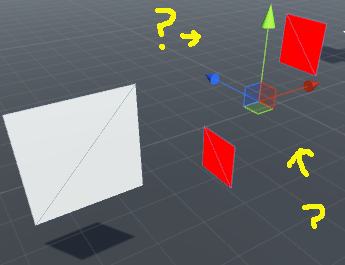I am playing with a geometry shader and I am wondering why it doesn't generate geometry for each vertex in all meshes?
- I don't think this is a Cull problem because the same vertices generate geometry as you rotate around and setting
Cull Offchanges nothing. - Another problem could be a multiply by zero somewhere but I tried to eliminate as many variables as possible and still have the issue.
- A third unlikely issue could be limiting the output amount somewhere. I didn't set anything explicitly to hinder that.
I notice the problem on a Cube(5/8) and Quad(2/4) but seems to generate all the geometry fine on a plane, cylinder, etc. The following are some results from using the bare-bones geometry shader.
Cube (closest: Unity default, further back: Cinema 4D exported .fbx cube):

Quad:

It seems to work fine on a plane (update: It is actually missing a whole row on each axis)

Unity Shader Code GeometryShaderTest1.shader:
Note: If you are testing out the shader and nothing is displaying; Rotate your camera around so the normals are facing the right direction to show up.
Shader "Custom/GeometryShaderTest1" {
Properties {
_Color ("Color", Color) = (1,1,1,1)
_Amount ("Height Adjustment", Float) = 0.0
}
SubShader {
Pass {
Tags { "RenderType"="Opaque" }
LOD 200
CGPROGRAM
#pragma target 5.0
//#pragma addshadow
#pragma vertex vert
#pragma geometry GS_Main
#pragma fragment frag
#include "UnityCG.cginc"
// Vert to geo
struct v2g
{
float4 pos: POSITION;
};
// geo to frag
struct g2f
{
float4 pos: POSITION;
};
// Vars
fixed4 _Color;
float _Amount;
// Vertex modifier function
v2g vert(appdata_base v) {
v2g output = (v2g)0;
output.pos = mul(_Object2World, v.vertex);
// Just testing whether all vertices affected
output.pos.y -= _Amount;
return output;
}
// GS_Main(point v2g p[1], inout TriangleStream<g2f> triStream)
// GS_Main(line v2g p[2], inout TriangleStream<g2f> triStream)
// GS_Main(triangle v2g p[3], inout TriangleStream<g2f> triStream)
[maxvertexcount(4)]
void GS_Main(point v2g p[1], inout TriangleStream<g2f> triStream)
{
float4 v[4];
float3 asdfUp = float3(0, 1, 0);
float3 asdfRight = float3(0, 0, 1);
v[0] = float4(p[0].pos + 0.25 * asdfRight - 0.25 * asdfUp, 1.0f);
v[1] = float4(p[0].pos + 0.25 * asdfRight + 0.25 * asdfUp, 1.0f);
v[2] = float4(p[0].pos - 0.25 * asdfRight - 0.25 * asdfUp, 1.0f);
v[3] = float4(p[0].pos - 0.25 * asdfRight + 0.25 * asdfUp, 1.0f);
float4x4 vp = mul(UNITY_MATRIX_MVP, _World2Object);
g2f pIn;
pIn.pos = mul(vp, v[0]);
triStream.Append(pIn);
pIn.pos = mul(vp, v[1]);
triStream.Append(pIn);
pIn.pos = mul(vp, v[2]);
triStream.Append(pIn);
pIn.pos = mul(vp, v[3]);
triStream.Append(pIn);
}
fixed4 frag(g2f input) : COLOR {
return float4(1.0, 0.0, 0.0, 1.0);
}
ENDCG
}
}
FallBack "Diffuse"
}
Geometry shader resources:
- Geometry shader with shadows not displaying shadows properly - Unity forums
- This isn't exactly OpenGL but good info: Geometry Shader and Vertex Shader
- Billboarding Geometry shader example here and here
